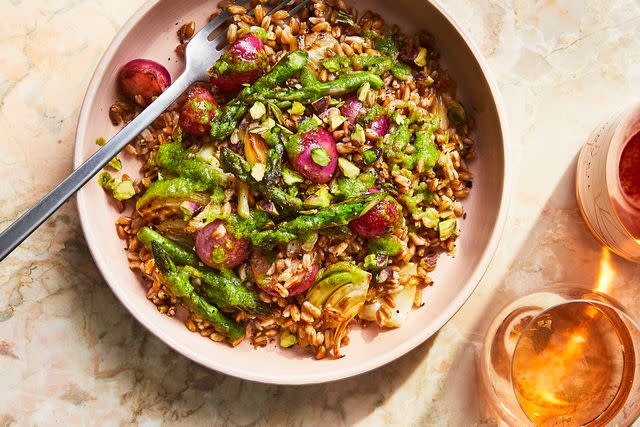The #1 Whole Grain to Eat to Help Decrease Inflammation, According to a Dietitian
It’s nutty, chewy and tasty for breakfast, lunch or dinner.
Reviewed by Dietitian Emily Lachtrupp, M.S., RD
Inflammation has long been Enemy No. 1 when it comes to your health. It’s not all bad, though. After all, inflammation promotes healing during injury or infection. After a few hours to several days, it subsides when you’re all better. However, an inflammatory response that lingers and becomes chronic can put you at increased risk for heart disease, type 2 diabetes and cancer, among other conditions.
Related: The Best Foods to Eat to Fight Inflammation
Luckily, lifestyle changes and healthy eating habits can often keep chronic inflammation in check. Adopting an anti-inflammatory diet can help. This style of eating is similar to the popular Mediterranean diet, since both emphasize anti-inflammatory foods like fruits, vegetables and whole grains.
And speaking of whole grains, these foods are top inflammation fighters. They’re all good to have on your plate, but one earns our top pick for a top anti-inflammatory grain.

PHOTOGRAPHER: GREG DUPREE, FOOD STYLIST: MARTGARET DICKEY PROP STYLIST: KAY CLARKE
How Whole Grains Help Fight Inflammation
Whole grains have a reputation as a healthy food—and for good reason. “Whole grains are part of a balanced diet and are known for their role in reducing the risk of chronic diseases like heart disease, diabetes and even some forms of cancer,” says Seattle-based registered dietitian nutritionist, Ginger Hultin, M.S., RDN, owner of Ginger Hultin Nutrition and author of Anti-Inflammatory Diet Meal Prep. “A lot of people don’t realize that whole grains can help lower chronic inflammation levels in the body,” she adds.
A 2022 study published in JAMA Network Open, analyzed data collected from over 4,000 adults and compared whether the source of dietary fiber (cereals, fruits, vegetables) made a difference on markers of inflammation. Cereal fiber from whole grains was linked to significantly lower markers of inflammation than fiber from either fruits or vegetables.
“The reason [whole grains] play a role in managing systemic inflammation is because they are rich in fiber, which aids both in detoxification and maintaining a healthy gut microbiome, a critical component for a robust immune system and controlling inflammation,” Hultin explains. When beneficial bacteria in the gut ferment whole-grain fiber, they produce compounds, such as short-chain fatty acids, that may help reduce inflammation, per a 2020 review in Nutrition Reviews.
The No. 1 Whole Grain for Decreasing Inflammation
Picking just one whole grain for decreasing inflammation was difficult since they all have so much to offer. In the end, farro (aka emmer) was our top whole-grain pick. Here’s why.
Packed with Fiber
As previously mentioned, the fiber in whole grains is part of the reason they have so many anti-inflammatory benefits. When choosing a whole grain to boost your fiber intake, farro is an excellent choice. Just 1/4 cup uncooked farro (about ½ cup cooked) provides 5 grams of fiber, according to the USDA. It’s recommended you aim for 28 to 34 grams of fiber per day, making farro a good source of the nutrient.
Rich in Antioxidants
Farro contains a variety of antioxidants. These are beneficial compounds in foods that can prevent damage caused by free radicals. Although free radicals are produced naturally in the body, if left unchecked they can contribute to chronic inflammation. Farro contains antioxidants like carotenoids, as well as tocotrienols. Carotenoids are yellow, orange and red pigments typically found in veggies like carrots and bell peppers, notes the Linus Pauling Institute at Oregon State University. Tocotrienols are compounds in the vitamin E family with antioxidant and anti-inflammatory properties, per a 2021 review from the Institute of Human Nutrition Sciences.
Contains Inflammation-Battling Betaine
Our body naturally produces the compound betaine when it metabolizes the nutrient choline, but betaine can also be found in certain foods like beets, spinach and whole grains, according to a 2023 study in BMC Endocrine Disorders. And, you guessed it—farro contains the compound betaine, according to a 2018 article in the Journal of Cereal Science. As noted in a 2023 article in Molecules, there is new interest in betaine as a possible ingredient with anti-inflammatory benefits.
A Versatile Grain
Unlike oats, which are generally reserved for breakfast, farro can be used in a variety of dishes from porridge to soups and salads. If oatmeal is your go-to breakfast, try this Slow-Cooker Overnight Farro Porridge. Add tons of fiber to soup by incorporating farro like we did in this Slow-Cooker Italian Vegetable & Farro Soup. Use farro as a stand-in for rice in risotto in this Farro Risotto with Mushrooms & Greens.
Bottom Line
Even though inflammation is a normal and important part of our body’s natural defense system, chronic inflammation puts you at risk for a bevy of health conditions. Luckily, incorporating anti-inflammatory foods like fruits, vegetables and whole grains into your diet can help tame chronic inflammation. Our top whole-grain pick for inflammation is farro, since it’s packed with fiber and antioxidants while also being a versatile pantry staple.
Read the original article on Eating Well.

